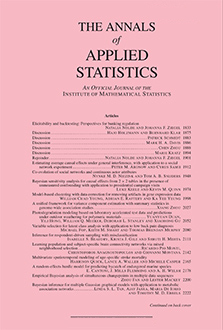Abstract
Capture–recapture data are often collected when abundance estimation is of interest. In this manuscript we focus on abundance estimation of closed populations. In the presence of unobserved individual heterogeneity, specified on a continuous scale for the capture probabilities, the likelihood is not generally available in closed form, but expressible only as an analytically intractable integral. Model-fitting algorithms to estimate abundance most notably include a numerical approximation for the likelihood or use of a Bayesian data augmentation technique considering the complete data likelihood. We consider a Bayesian hybrid approach, defining a “semi-complete” data likelihood, composed of the product of a complete data likelihood component for individuals seen at least once within the study and a marginal data likelihood component for the individuals not seen within the study, approximated using numerical integration. This approach combines the advantages of the two different approaches, with the semi-complete likelihood component specified as a single integral (over the dimension of the individual heterogeneity component). In addition, the models can be fitted within BUGS/JAGS (commonly used for the Bayesian complete data likelihood approach) but with significantly improved computational efficiency compared to the commonly used superpopulation data augmentation approaches (between about 10 and 77 times more efficient in the two examples we consider). The semi-complete likelihood approach is flexible and applicable to a range of models, including spatially explicit capture–recapture models. The model-fitting approach is applied to two different data sets: the first relates to snowshoe hares where model $M_{h}$ is applied and the second to gibbons where a spatially explicit capture–recapture model is applied.
Citation
Ruth King. Brett T. McClintock. Darren Kidney. David Borchers. "Capture–recapture abundance estimation using a semi-complete data likelihood approach." Ann. Appl. Stat. 10 (1) 264 - 285, March 2016. https://doi.org/10.1214/15-AOAS890
Information





